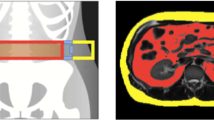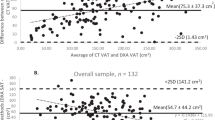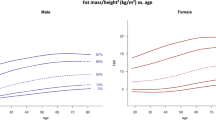Abstract
Quantification of abdominal visceral adipose tissue (VAT) is important to understand obesity-related comorbidities. We hypothesized that dual X-ray absorptiometry (DXA) measurements of VAT would correlate with traditional gold standards of magnetic resonance imaging (MRI) and computed tomography (CT) in older men. Deming regression and Bland–Altman plots were used to assess the agreement between VAT measured simultaneously by DXA and MRI (n=95) in a cohort of older males participating in a randomized trial of testosterone replacement for diabetes. We also correlated DXA with single-slice CT (n=102) in a cohort of older males undergoing testosterone deprivation for prostate cancer. Lunar Prodigy DXA scanners using enCORE software was used to measure VAT. DXA VAT volume strongly correlated with MRI VAT volume (r=0.90, P<0.0001) and CT VAT area (r=0.83, P<0.0001). As DXA assesses VAT volume in a smaller compartment than MRI, Bland–Altman analysis demonstrated DXA systematically underestimated VAT by an approximately 30% proportional bias. DXA VAT volume measured by Lunar Prodigy DXA scanners correlate well with gold standard MRI and CT quantification methods, and provides a low radiation, efficient, cost-effective option. Future clinical studies examining the effects of interventions on body composition and regional fat distribution may find DXA an appropriate volumetric method to quantify VAT.
This is a preview of subscription content, access via your institution
Access options
Subscribe to this journal
Receive 12 print issues and online access
$259.00 per year
only $21.58 per issue
Buy this article
- Purchase on Springer Link
- Instant access to full article PDF
Prices may be subject to local taxes which are calculated during checkout

Similar content being viewed by others
References
Kuk JL, Katzmarzyk PT, Nichaman MZ, Church TS, Blair SN, Ross R . Visceral fat is an independent predictor of all-cause mortality in men. Obesity 2006; 14: 336–341.
Gastaldelli A, Sironi AM, Ciociaro D, Positano V, Buzzigoli E, Giannessi D et al. Visceral fat and beta cell function in non-diabetic humans. Diabetologia 2005; 48: 2090–2096.
Yamaji T, Iwasaki M, Sasazuki S, Kurahashi N, Mutoh M, Yamamoto S et al. Visceral fat volume and the prevalence of colorectal adenoma. Am J Epidemiol 2009; 170: 1502–1511.
Lee YH, Lee SH, Jung ES, Kim JS, Shim CY, Ko YG et al. Visceral adiposity and the severity of coronary artery disease in middle-aged subjects with normal waist circumference and its relation with lipocalin-2 and MCP-1. Atherosclerosis 2010; 213: 592–597.
Kaul S, Rothney MP, Peters DM, Wacker WK, Davis CE, Shapiro MD et al. Dual-energy X-ray absorptiometry for quantification of visceral fat. Obesity 2012; 20: 1313–1318.
Rothney MP, Xia Y, Wacker WK, Martin FP, Beaumont M, Rezzi S et al. Precision of a new tool to measure visceral adipose tissue (VAT) using dual-energy X-Ray absorptiometry (DXA). Obesity 2013; 21: E134–E136.
Gianatti EJ, Dupuis P, Hoermann R, Strauss BJ, Wentworth JM, Zajac JD et al. Effect of testosterone treatment on glucose metabolism in men with type 2 diabetes: a randomized controlled trial. Diabetes Care 2014; 37: 2098–2107.
Hamilton EJ, Gianatti E, Strauss BJ, Wentworth J, Lim-Joon D, Bolton D et al. Increase in visceral and subcutaneous abdominal fat in men with prostate cancer treated with androgen deprivation therapy. Clin Endocrinol (Oxf) 2011; 74: 377–383.
Carver TE, Court O, Christou NV, Reid RE, Andersen RE . Precision of the iDXA for visceral adipose tissue measurement in severely obese patients. Med Sci Sports Exerc 2014; 46: 1462–1465.
Ross R, Leger L, Morris D, de Guise J, Guardo R . Quantification of adipose tissue by MRI: relationship with anthropometric variables. J Appl Physiol 1992; 72: 787–795.
Bland J, Altman D . Statistical methods for assessing agreement between two methods of clinical measurement. Lancet 1986; 1: 307–310.
RCoreTeam R . A Language and Environment for Statistical Computing. In: R Foundation for Statistical Computing: Vienna, Austria, 2015.
Manuilova E, Schuetzenmeister A, Model F . mcr: Method Comparison Regression. In: R package version 1.2.1, 2014.
Yoon DY, Moon JH, Kim HK, Choi CS, Chang SK, Yun EJ et al. Comparison of low-dose CT and MR for measurement of intra-abdominal adipose tissue: a phantom and human study. Acad Radiol 2008; 15: 62–70.
Sjostrom L . A computer-tomography based multicompartment body composition technique and anthropometric predictions of lean body mass, total and subcutaneous adipose tissue. Int J Obesity 1991; 15: 19–30.
Thomas EL, Saeed N, Hajnal JV, Brynes A, Goldstone AP, Frost G et al. Magnetic resonance imaging of total body fat. J Appl Physiol 1998; 85: 1778–1785.
Greenfield JR, Samaras K, Chisholm DJ, Campbell LV . Regional intra-subject variability in abdominal adiposity limits usefulness of computed tomography. Obesity Res 2002; 10: 260–265.
Klopfenstein BJ, Kim MS, Krisky CM, Szumowski J, Rooney WD, Purnell JQ . Comparison of 3T MRI and CT for the measurement of visceral and subcutaneous adipose tissue in humans. Br J Radiol 2012; 85: e826–e830.
Acknowledgements
This study was supported by an National Health and Medical Research Council of Australia (NHMRC) project grant (#1006407). ASC is supported by a NHMRC postgraduate scholarship (#1017233) to undertake this project as part of a PhD. MG is supported by a NHMRC Career Development Fellowship (#1024139). enCORE software version 16 was provided by MedTel, agents for GE Lunar in Australia. MedTel and GE Lunar were not involved in the design, selection of study participants, analysis of the data, interpretation of the results or the manuscript preparation.
Author information
Authors and Affiliations
Corresponding author
Ethics declarations
Competing interests
The authors declare no conflict of interest.
Rights and permissions
About this article
Cite this article
Cheung, A., de Rooy, C., Hoermann, R. et al. Correlation of visceral adipose tissue measured by Lunar Prodigy dual X-ray absorptiometry with MRI and CT in older men. Int J Obes 40, 1325–1328 (2016). https://doi.org/10.1038/ijo.2016.50
Received:
Revised:
Accepted:
Published:
Issue Date:
DOI: https://doi.org/10.1038/ijo.2016.50
This article is cited by
-
Assessment of whole-body and regional body fat using abdominal quantitative computed tomography in Chinese women and men
Lipids in Health and Disease (2024)
-
Novel lipid indicators and the risk of type 2 diabetes mellitus among Chinese hypertensive patients: findings from the Guangzhou Heart Study
Cardiovascular Diabetology (2022)
-
Body fat and risk of all-cause mortality: a systematic review and dose-response meta-analysis of prospective cohort studies
International Journal of Obesity (2022)
-
Accuracy of dual-energy x-ray absorptiometry for assessing longitudinal change in visceral adipose tissue in patients with coronary artery disease
International Journal of Obesity (2021)
-
Comparison of abdominal visceral adipose tissue measurements in adolescents between magnetic resonance imaging and dual-energy X-ray absorptiometry
International Journal of Obesity (2021)



